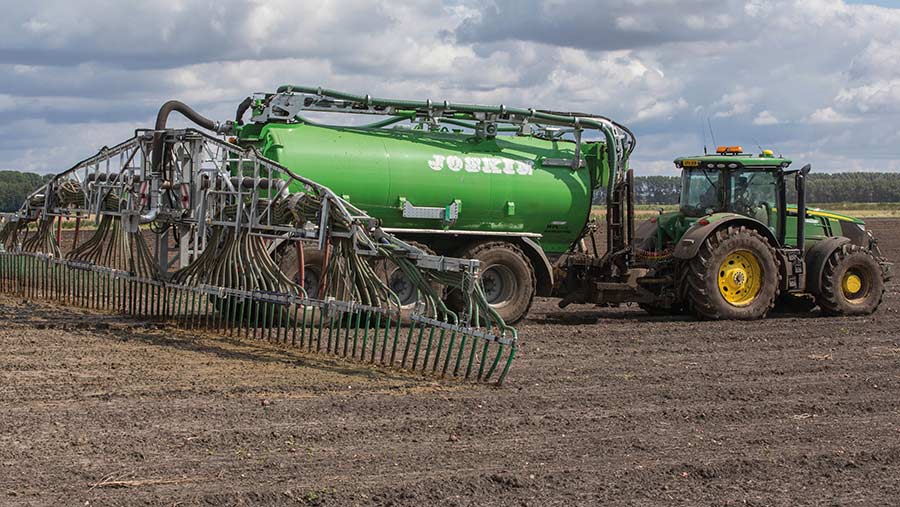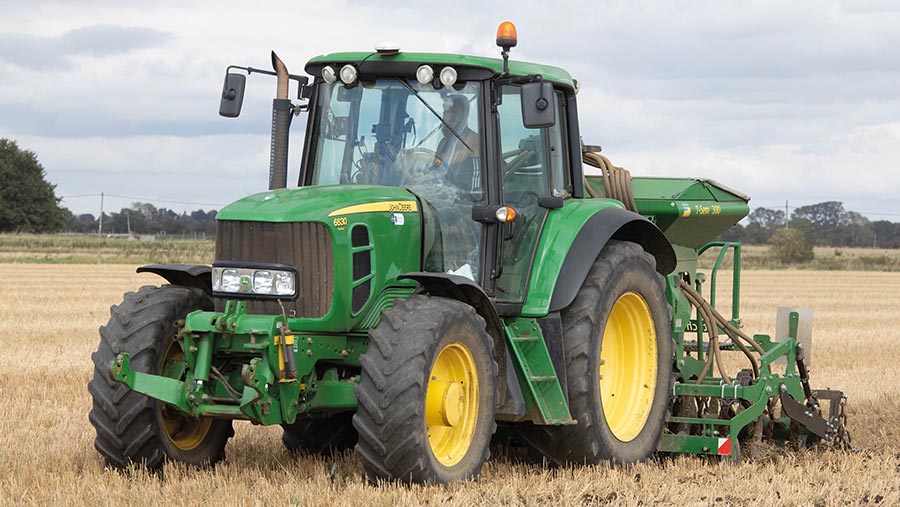A guide to the updated autumn manure spreading rules
 © Tim Scrivener
© Tim Scrivener Updated guidance on how the Environment Agency (EA) should apply the Farming Rules for Water has cleared the way for muckspreading this coming autumn and winter. This is provided there is no water pollution risk from the application of muck and other organic manures.
Following collaboration between industry and government, practical solutions that work for both farming and the environment have been developed, with both sides taking a flexible approach in their mutual desire to reach a workable compromise.
See also: Beans and oats bicrop helps eliminate fertiliser on Cambs farm
The latest information does not amend the regulations that came out in 2018, but it does clarify the confusion that arose last autumn when the EA took everyone by surprise with its regulatory position statement 252.
That move was seen by the industry as extremely difficult to comply with and at odds with Defra’s position on soil health, which will increasingly require farmers to both test for soil organic matter and apply organic matter to a proportion of their land.
Rising fertiliser costs
Against the current background of rising fertiliser prices, disruption to supplies and soaring food prices, the nutrient value of these organic materials and the practicalities involved with spreading them has been recognised by the update.
Far from being a green light for all types of spreading, the pollution risks associated with different types of manures and the need to demonstrate that applications have been planned and accounted for are central to the guidance.
The aim is to encourage best practice and responsible use, and the EA will still have the power to take action, if appropriate, where repeated warnings are ignored.
For arable farmers, it means they will be able to apply organic manures in the autumn to winter crops and ahead of spring cropping without the fear of prosecution. However, they must show they have taken reasonable precautions and planned their applications within the guidelines.
Best practice
As the Association of Independent Crop Consultants representative, Andrew Watson of Niab, explains, the onus is now on farmers to use manures and slurries in the right way and recognise that water pollution is a serious issue for the industry.
“No one goes out of their way to pollute water,” he stresses. “There are conditions, however, that can make muckspreading a problem. With this updated guidance, those should be eliminated, while farmers can still make use of these valuable materials in such uncertain times.”
Getting the best out of manures and using them to replace the need for some bagged nitrogen comes from spring applications, he explains, as that is when there is the biggest crop need.
“However, farmers still need to be able to put them on the autumn – for reasons that may be due to soil conditions, cultivation policy or cropping, or a combination of all three,” Mr Watson says.
Crucially, farmers should always consider the need for nitrogen based on the annual crop cycle, he adds.

© Tim Scrivener
Rates and restrictions
Looking ahead to this autumn, there are restrictions growers need to be aware of, he says. With high readily available nitrogen (RAN) materials there are application rate limits and time periods to observe, to address the nitrate leaching risk.
“A high-RAN organic manure is one with a readily available nitrogen content above 30%, so it includes slurries, digestate and poultry manure,” explains Mr Watson.
For these manures, there is a single application rate limit of 30cu m/ha or 8t/ha in the designated time periods (see “High-RAN manure: time period and application rate limits”), with no repeat applications allowed within 21 days.
Outside of these months, there is no application rate limit, other than nitrate vulnerable zone and good agricultural practice limits of 250kg total N/ha.
At all times, the amount applied should meet the soil and crop needs of the autumn-sown commercial crop, and all reasonable precautions should be taken to prevent diffuse pollution.
A low-RAN organic manure – one with a RAN content below 30% – does not have an application rate limit under the Farming Rules for Water, but precautions must be taken and the soil and crop need observed.
High-RAN manure: time period and application rate limits |
||
| Soil type | Grassland | Tillage land |
| Sandy or shallow soil | 1 September to end Feb | 1 August-end Feb |
| All other soils | 15 Oct-end Feb | 1 Oct-end Feb |
Reasonable precautions
Green cover must be established by 15 October where manures are being applied. This can be a crop, green manure or cover crop depending on the circumstances, says Mr Watson.
“There are a couple of exemptions to this – such as where delayed drilling is used to help with grassweed control, or where soils need to weather before a root crop is drilled in the spring,” he adds.
In addition, farmers should incorporate manures into soils to limit any diffuse pollution, unless there are practical reasons not to.
“There is flexibility, which has been welcomed,” reports Mr Watson. “It shows what can be achieved when everyone works together and puts the focus on finding solutions.”
Planning manure applications
As before, a nutrient management plan will be required and must show how application decisions have been made.
This means having an assessment of the crop need, made using either RB209 or specialist farm software, or by the farm’s agronomist.
Soil sampling results and the nutrient content of any manures, as well as bagged fertilisers, will also be required.
“This is to show that the applications have been appropriate and the right decisions made about how much to apply,” explains Mr Watson. “None of these things are difficult or onerous to do.”
Phosphorus
Don’t apply manures that will raise the soil phosphorus index above 3, wherever possible, or target them across a rotation, says the latest guidance.
Where there are difficulties complying with this guidance, there are exceptions – such as where the farm produces its own manures and can’t take measures to treat or manage it accordingly, or where a farm imports manure as part of an integrated fertiliser system.
Nitrate vulnerable zone rules
If you are farming in a nitrate vulnerable zone, you must continue to follow the rules and stick to manure limits and closed periods, which are unchanged by the new guidance.
River pollution – current situation
Only 14% of English rivers meet good ecological status and farmers are just one of many groups that need to do their bit.
There is no single culprit – waterways are damaged by a range of pollutants, which come from sewage, agriculture, roads and single-use plastics, with pharmaceuticals also being an emerging concern.
Both agricultural and urban run-off are highlighted as sources of diffuse pollution, but there are also about 3,000 pollution incidents involving oils and fuel every year.

